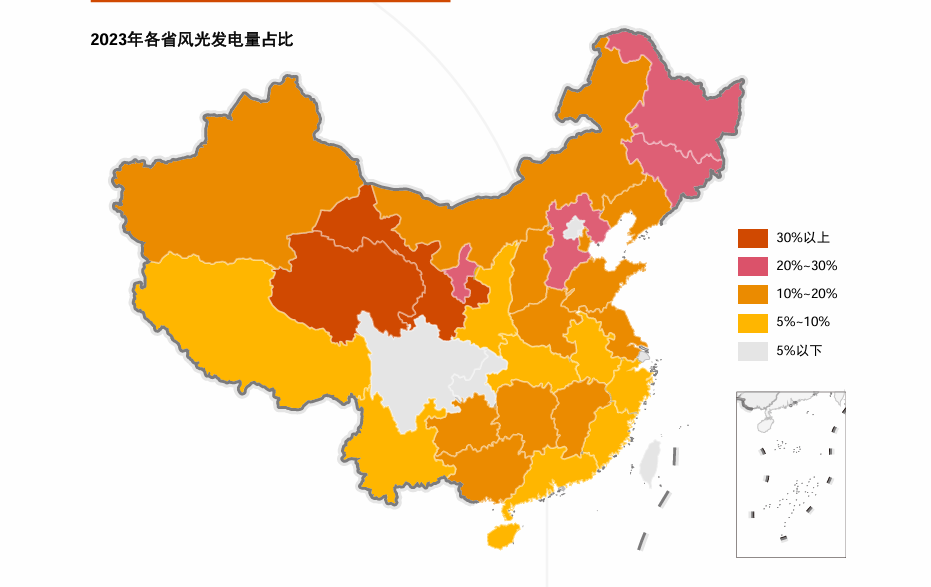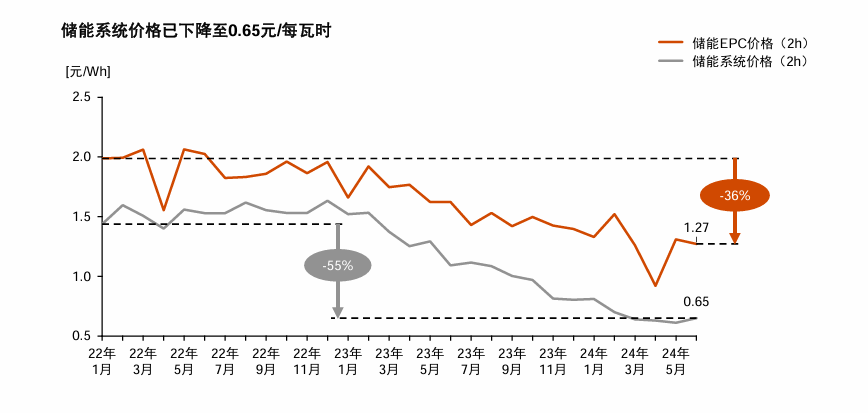Over the past decade, China has seen rapid development of renewable energy, with wind and solar power generation continuing to increase, with six provinces now accounting for more than 20% of wind and solar power generation. In order to solve the problem of new energy consumption and meet the demand for flexible resources for delivery, mandatory energy storage policies and installation targets during the 14th Five-Year Plan period have been introduced, thus forming an urgent need for large-scale energy storage installation. According to the report of PwC, it is estimated that by 2030, China's cumulative wind and solar capacity will reach 1,955GW, and the new cumulative wind and solar capacity will reach 900GW in 2023~2030, and the new energy capacity will bring at least 180GW of energy storage demand based on the 20% distribution and storage ratio, making wind and solar distribution and storage an indispensable part of renewable energy development.
PwC predicts that wind and solar distribution and storage has become a rigid demand, but the economics of source-side distribution and storage need to be improved.
Wind and solar power distribution and storage refers to the combination of wind power generation and photovoltaic power generation with energy storage systems to improve the stability of the power system and the utilization rate of renewable energy. Specifically, wind-solar distribution and storage technology can smooth unstable photovoltaic power generation and wind power, increase the proportion of renewable energy, and cooperate with conventional thermal power, nuclear power and other power sources to provide auxiliary services such as peak regulation and frequency regulation for the operation of the power system, and improve the flexibility of the power system. This configuration helps to solve the problems of low comprehensive efficiency of the power system, insufficient coordination of various links of "source-grid-load-storage", and insufficient complementarity and mutual assistance of various power sources, and is an important means to promote the realization of the goal of "carbon peak and carbon neutrality".
The wind-solar-storage integration project optimizes the scale of supporting energy storage, gives full play to the role of supporting energy storage in peak regulation and frequency regulation, minimizes the comprehensive power generation cost of wind, solar and storage, and enhances comprehensive competitiveness. Energy storage technology has a wide range of application scenarios, including the power generation side to stabilize output fluctuations, absorb wind and solar curtailment, the grid side to provide power auxiliary services to enhance the stability of the power grid, and the user side to support distributed photovoltaic power generation or arbitrage through peak-to-valley price differences.

Figure: Proportion of wind and solar power generation by province in 2023 (Source: PwC)
Source-side distribution and storage refers to the configuration of energy storage systems on the power generation side, mainly involving renewable energy power generation projects such as photovoltaic, wind power, and hydropower. These energy storage systems cooperate with thermal power plants and power grids to carry out peak and frequency regulation, and the main operation mode is to obtain revenue.
At the same time, source-side distribution and storage can also improve the "three abandonments" of renewable energy, namely curtailment of wind, solar and water, especially in areas where large ground power stations are concentrated in Qinghai and Ningxia, and the installation of energy storage systems can effectively reduce the curtailment rate.
Source-side distribution and storage mainly includes traditional energy storage based on pumped storage and new energy storage represented by electrochemical energy storage.
This configuration helps smooth out the intermittency and volatility of renewable energy, improving the stability of the power system and the utilization rate of renewable energy. According to the analysis, the current internal rate of return (IRR) of domestic power generation side distribution and storage is about 4.5%, while the IRR requirement for photovoltaic and wind power generation is generally about 8%, and the IRR is reduced to 6%-7% after distribution and storage. This means that, based on the current level of electricity prices, the economics of wind, solar distribution and storage on the power generation side have not yet met investors' expectations.

Figure: Energy storage system price trend (Source: PwC)
The marketization of electricity is deep, and the profitability of energy storage is diversified
The reform of the electricity market is a key factor in promoting the diversification of the profit model of the energy storage industry. With the support of national and local policies, independent energy storage has gradually participated in various markets, including the medium and long-term market, spot market, ancillary service market such as frequency modulation, and capacity compensation market. The opening of these markets provides more profit opportunities for energy storage. In addition, independent energy storage is gradually participating in various markets, and its profit models include medium and long-term, spot market, auxiliary services such as frequency modulation, capacity compensation, etc. In the U.S., there are already a variety of profit models for energy storage projects, including capacity markets, spot power market arbitrage, and ancillary services markets (frequency modulation, rotary/non-rotating backup, etc.).
Although the energy storage industry has a clear trend of diversification of profit models, it still faces some challenges. For example, the construction and operating costs of energy storage systems are high, and it is necessary to continuously reduce costs to improve economy; At the same time, the safety and reliability of the energy storage system need to be further guaranteed. However, with the large-scale integration of new energy into the grid and the continuous improvement of the power market, the energy storage industry has also ushered in unprecedented development opportunities. The continuous support of government policies, the cost reduction brought about by technological progress, and the continuous expansion of application scenarios will provide a strong guarantee for the future development of the energy storage industry.
Related:






